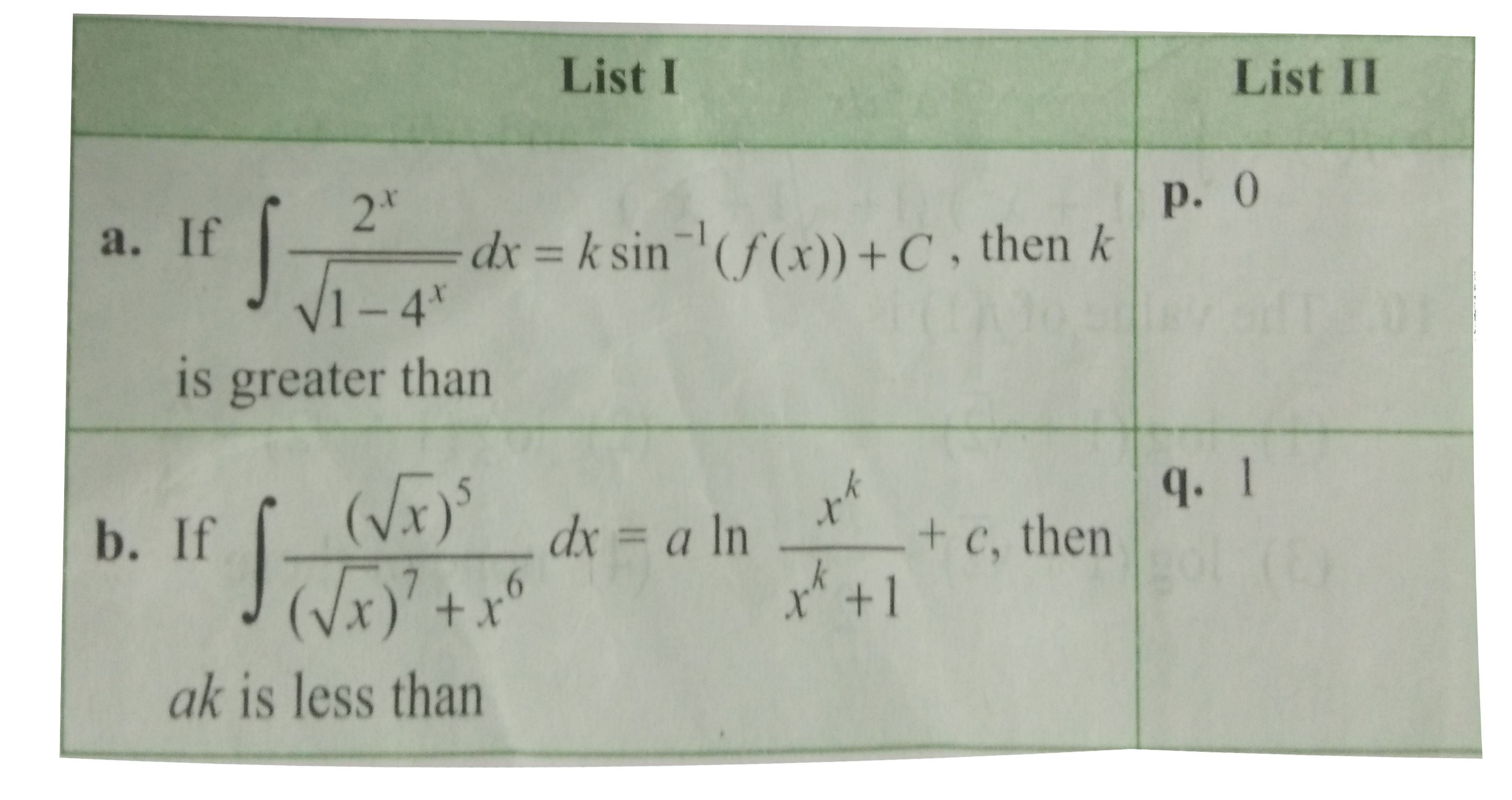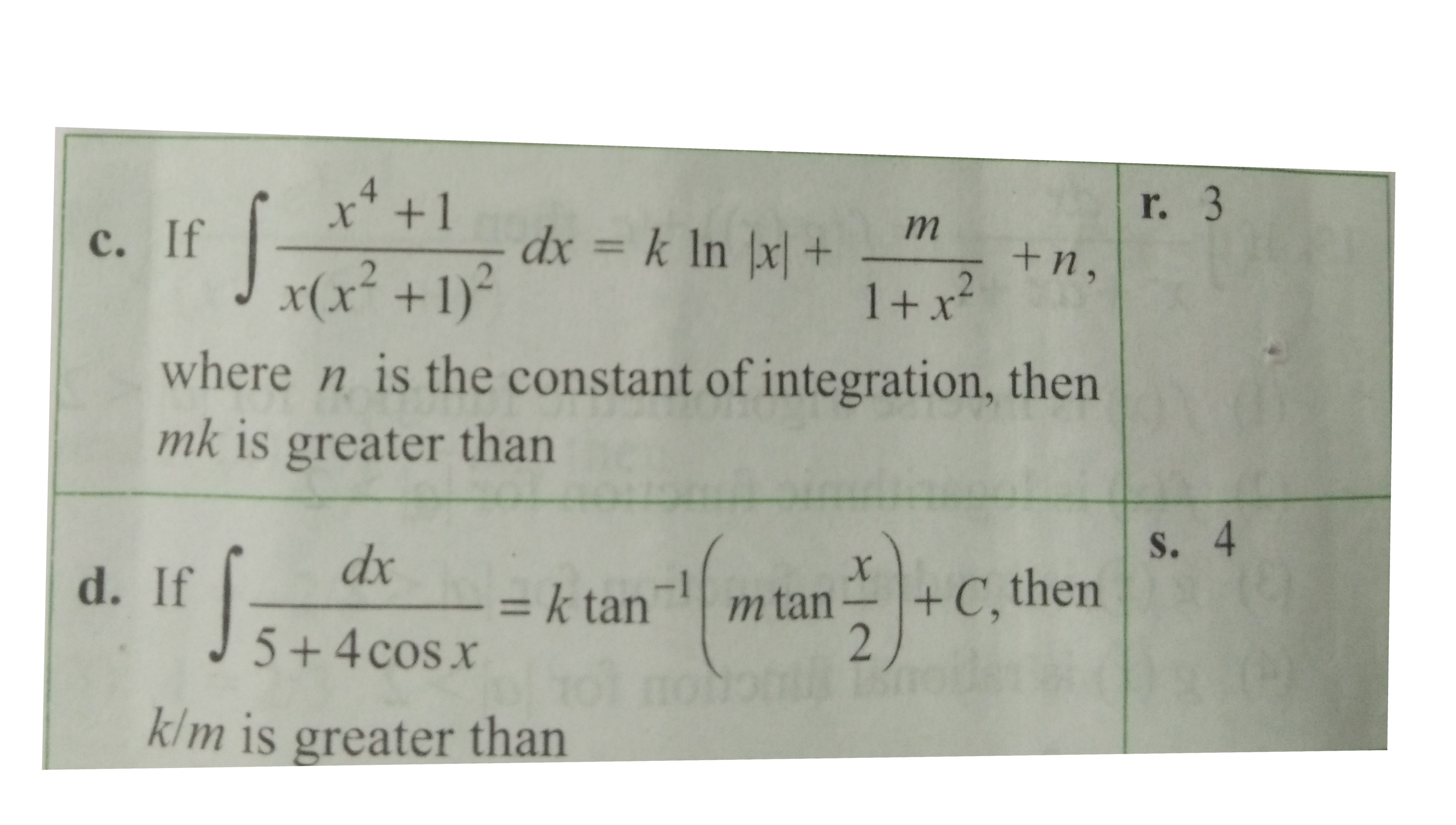y=f(x) is a polynomial function passing through point (0, 1) and which increases in the intervals (1,2)and(3,∞) and decreases in the intervals (∞,1)and(2,3).
If f(x)=0 has four real roots, then the range of values of leading coefficient of polynomial is Solution in Bengali
[4/9, 1/2]
[4/9, 1]
[1/3, 1/2]
none of these
The correct Answer is:A
From the given data, we can conclude that dydx=0 at x=1,2,3.
Hence, f'(x)=a(x−1)(x−2)(x−3),a>0
⇒f(x)=∫a(x3−6x2+11x−6)dx
=a(x44−2x3+11x22−6x)+C
Also, f(0)=1⇒c=1
∴f(x)=a(x44−2x3+11x22−6x)+1 (1)
So, graph is symmetrical about line x=2 and range is [f(1),∞)or[f(3),∞).
For f(x)=0, we have x44−2x3+11x22−6x=−1a
For x=1,−94=−1a or a=49
For x=2,−2=−1a or a=12
So, f(x)=0 has four roots if a∈[49,12].
Topper's Solved these Questions
- BOOK - CENGAGE PUBLICATIONCHAPTER - INDEFINITE INTEGRATIONEXERCISE - EXERCISES (Matrix Match Type)4videos
INDEFINITE INTEGRATION
- BOOK - CENGAGE PUBLICATIONCHAPTER - INDEFINITE INTEGRATIONEXERCISE - EXERCISES (Numerical Value Type)10videos
INDEFINITE INTEGRATION
- BOOK - CENGAGE PUBLICATIONCHAPTER - INDEFINITE INTEGRATIONEXERCISE - Exercises (Multiple Correct Answers Type)17videos
INDEFINITE INTEGRATION
- BOOK - CENGAGE PUBLICATIONCHAPTER - HYPERBOLAEXERCISE - COMPREHENSION TYPE2videos
HYPERBOLA
- BOOK - CENGAGE PUBLICATIONCHAPTER - INEQUALITIES AND MODULUSEXERCISE - Single correct Answer21videos
INEQUALITIES AND MODULUS
Similar Questions
Match the following lists:

 03:33View Solution
03:33View SolutionLet f(x)=∫xsinx(1+xcosx.lnx+sinx)dxandf(π2)=π24. Then the value of |cos(f(π))| is____
05:40View SolutionEvaluate:∫dx√2ex−1=
01:29View SolutionThe circle x2+y2−8x=0 and hyperbola x29−y24=1 I intersect at the points A and B. Equation of a common tangent with positive slope to the circle as well as to the hyperbola is (A) 2x−√5y−20=0 (B) 2x−√5y+4=0 (C) 3x−4y+8=0 (D) 4x−3y+4=0
View SolutionIf f(x)=ax2+bx+c and f(−1)≥−4, f(1)≤0 and f(3)≥5, then the least value of a is
03:15View SolutionShow that f(x)=11+x2 decreases in the interval [0,∞) and increases in the interval (−∞,0].
View SolutionLet f(x) be a cubic polynomial on R which increases in the interval (-oo,0)uu(1,oo) and decreases in the interval (0,1). If f'(2)=6 and f(2)=2, then the value of tan^(-1)(f(1))+tan^(-1)(f((3)/(2)))+tan^(-1)(f(0)) equals
05:03View SolutionShow that f(x)=11+x2 decreases in the interval [0, ∞) and increases in the interval (−∞, 0] .
03:42View Solutiony=f(x) is a polynomial function passing through point (0, 1) and which increases in the intervals (1,2)and(3,∞) and decreases in the intervals (∞,1)and(2,3).
If f(1)=−8, then the value of f(2) is11:11View Solutiony=f(x) is a polynomial function passing through point (0, 1) and which increases in the intervals (1,2)and(3,∞) and decreases in the intervals (∞,1)and(2,3).
If f(1)=−8, then the range of f(x) is02:55View Solutiony=f(x) is a polynomial function passing through point (0, 1) and which increases in the intervals (1,2)and(3,∞) and decreases in the intervals (∞,1)and(2,3).
If f(x)=0 has four real roots, then the range of values of leading coefficient of polynomial is03:20View Solutiony=f(x) is a polynomial function passing through point (0, 1) and which increases in the intervals (1,2)and(3,∞) and decreases in the intervals (∞,1)and(2,3).
If f(1)=−8, then the value of f(2) is06:23View Solutiony=f(x) is a polynomial function passing through point (0, 1) and which increases in the intervals (1,2)and(3,∞) and decreases in the intervals (−∞,1)and(2,3).
If f(1)=−8, then the range of f(x) is (a) [3,∞) (b) [−8,∞) (c) [−7,∞) (d) (−∞,6]08:03View Solutiony=f(x) is a polynomial function passing through point (0, 1) and which increases in the intervals (1,2)and(3,∞) and decreases in the intervals (∞,1)and(2,3).
If f(x)=0 has four real roots, then the range of values of leading coefficient of polynomial is04:19View SolutionShow that f(x)=11+x2 decreases in the interval [0,∞) and increases in the interval (−∞,0].
View SolutionShow that f(x)=11+x2 decreases in the interval [0, ∞) and increases in the interval (−∞, 0] .
09:47View Solution

